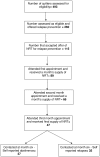Feasibility of offering nicotine replacement therapy as a relapse prevention treatment in routine smoking cessation services
- PMID: 23375024
- PMCID: PMC3639814
- DOI: 10.1186/1472-6963-13-38
Feasibility of offering nicotine replacement therapy as a relapse prevention treatment in routine smoking cessation services
Abstract
Background: National Health Service stop smoking services (NHS SSS) in the UK offer cost- effective smoking cessation services. Despite high abstinence rates after acute cessation treatment, the majority of clients have relapsed by one year. Several interventions have been identified, from trial data, as effective in preventing relapse to smoking. This study investigated uptake, feasibility and acceptability of offering nicotine replacement therapy (NRT) as a relapse prevention intervention (RPI) in NHS SSS.
Methods: Eligible smokers who had successfully completed acute cessation treatment using NRT at Nottingham City NHS SSS between April 2010 and January 2011 were offered the RPI and the rate of uptake was monitored. Consenting individuals completed a baseline questionnaire, providing demographic and smoking behaviour data. The RPI consisted of using NRT for a further 12 weeks after initial cessation-orientated treatment had ended. At a six-month review, self-reported smoking status was assessed via telephone. Anonymised demographic data on NHS SSS users who did not agree to participate in the study were retrieved from NHS SSS records and used to determine the presence of any socio-demographic differences between individuals who agreed to participate in the study and those who did not. Semi-structured telephone interviews were conducted with a selection of participants; these were audio-recorded, transcribed and analysed to identify participants' views on the RPI.
Results: Of 493 stop smoking service clients who were assessed, 260 were eligible for and offered the RPI and 115 (44%, CI 38%- 50%) accepted. Individuals who accepted NRT were significantly more likely to be older (p < 0.001) and to pay for their prescriptions (p < 0.001). Quitters who had never worked or were unemployed were significantly less likely to accept the offer of relapse prevention compared to those in routine and manual occupations (55% reduction in odds, p = 0.026).
Conclusion: In routine smoking cessation service care, it is feasible to offer clients extended courses of NRT as a RPI. The RPI was acceptable to them as almost half of the eligible clients offered this treatment accepted it.
Similar articles
-
Impact of specialist and primary care stop smoking support on socio-economic inequalities in cessation in the United Kingdom: a systematic review and national equity initial review completed 22 January 2019; final version accepted 19 July 2019 analysis.Addiction. 2020 Jan;115(1):34-46. doi: 10.1111/add.14760. Epub 2019 Sep 10. Addiction. 2020. PMID: 31357250 Free PMC article.
-
Using text messaging to prevent relapse to smoking: intervention development, practicability and client reactions.Addiction. 2012 Dec;107 Suppl 2:39-44. doi: 10.1111/j.1360-0443.2012.04084.x. Addiction. 2012. PMID: 23121358
-
Prevalence and Impact of Long-term Use of Nicotine Replacement Therapy in UK Stop-Smoking Services: Findings From the ELONS Study.Nicotine Tob Res. 2017 Dec 13;20(1):81-88. doi: 10.1093/ntr/ntw258. Nicotine Tob Res. 2017. PMID: 27664995 Free PMC article.
-
Evaluating Long-term Outcomes of NHS Stop Smoking Services (ELONS): a prospective cohort study.Health Technol Assess. 2015 Nov;19(95):1-156. doi: 10.3310/hta19950. Health Technol Assess. 2015. PMID: 26565129 Free PMC article.
-
The Impact of Smoking on the Development and Severity of Chronic Pain.Curr Pain Headache Rep. 2022 Aug;26(8):575-581. doi: 10.1007/s11916-022-01060-8. Epub 2022 Jun 22. Curr Pain Headache Rep. 2022. PMID: 35731364 Review.
Cited by
-
Impact of specialist and primary care stop smoking support on socio-economic inequalities in cessation in the United Kingdom: a systematic review and national equity initial review completed 22 January 2019; final version accepted 19 July 2019 analysis.Addiction. 2020 Jan;115(1):34-46. doi: 10.1111/add.14760. Epub 2019 Sep 10. Addiction. 2020. PMID: 31357250 Free PMC article.
-
A 'Cut-Down-To-Stop' intervention for smokers who find it hard to quit: a qualitative evaluation.BMC Public Health. 2019 Apr 15;19(1):403. doi: 10.1186/s12889-019-6738-9. BMC Public Health. 2019. PMID: 30987623 Free PMC article.
-
Nicotine replacement treatment, e-cigarettes and an online behavioural intervention to reduce relapse in recent ex-smokers: a multinational four-arm RCT.Health Technol Assess. 2020 Dec;24(68):1-82. doi: 10.3310/hta24680. Health Technol Assess. 2020. PMID: 33270009 Free PMC article. Clinical Trial.
-
Determinants of Smoking Cessation Outcomes and Reasons for Relapse in Patients Admitted to a Smoking Cessation Outpatient Clinic in Turkey.Int J Environ Res Public Health. 2024 Mar 7;21(3):310. doi: 10.3390/ijerph21030310. Int J Environ Res Public Health. 2024. PMID: 38541309 Free PMC article.
-
WhatsApp embedded in routine service delivery for smoking cessation: effects on abstinence rates in a randomized controlled study.BMC Public Health. 2019 Apr 8;19(1):387. doi: 10.1186/s12889-019-6727-z. BMC Public Health. 2019. PMID: 30961557 Free PMC article. Clinical Trial.
References
-
- The information Centre. Statistics on Smoking. England; 2011. pub 16/08/2011. Available at http://www.ic.nhs.uk/statistics-and-data-collections/health-and-lifestyl.... [Accessed on 19/12/11]
-
- Department of Health. Healthy Lives Healthy People: A New Tobacco Control Plan for England. England: Department of Health; 2011.
-
- Godfrey C, Parrot S, Coleman T, Pound E. The cost effectiveness of the English treatment services: evidence form practice. Addiction. 2005;100(Suppl 2):70–83. - PubMed
-
- Statistics on NHS Stop Smoking Services. The Health and Social Care Information Centre. England; April 2011 – December 2011. Available from URL: http://www.ic.nhs.uk/statistics-and-data-collections/health-and-lifestyl... [Accessed on 20/04/12]
-
- Royal College of Physicians. Nicotine Addiction in Britain. A report of the Tobacco Advisory Group of the Royal College of Physicians. London: RCP; 2000.
Publication types
MeSH terms
Grants and funding
LinkOut - more resources
Full Text Sources
Other Literature Sources
Medical
Miscellaneous


